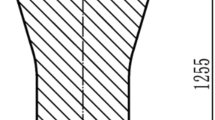Abstract
The two aims of this study are first, determining the optimal welding process parameters by using the finite element simulation and second, determining the optimal tempering temperature by evaluating the mechanical properties of friction welded part for manufacturing large rotor shaft. Inertia welding was conducted in order to make the large rotor shaft of turbo charger for low speed marine diesel engine. The rotor shaft is composed of the 310mm diameter disk and the 140mm diameter shaft. Since diameters of disk and shaft are very different, the integration using friction welding reduces manufacturing cost compared with the forming process of which a disk and shaft are forged into one body. Finite element simulation was performed, because inertial welding friction process depended on many process parameters, including axial force, initial revolution speed and energy, amount of upset, and working time. It is expected that this modeling will significantly reduce the number of experimental trials needed when determining the optimal welding parameters. Inertia welding was carried out with optimal process parameter conditions obtained from the simulation results. Welded joint part, made by friction welding, had very poor mechanical properties, and so it required heat treatment. The base material used in the investigation was SFCMV1 (SANYO special steel, high strength low alloy Cr-Mo steel) of 140mm diameter. In the study, heat treatment test carried out quenching (950 °C, 4hr, oil cooling) and tempering (690–720 °C, 6hr, air cooling) for friction welding specimens. The various tests, including microstructure observation, tensile, hardness, and fatigue tests, were conducted to evaluate the mechanical properties under various heat treatment conditions after inertia welding.
Similar content being viewed by others
Abbreviations
- E:
-
flywheel energy
- I:
-
inertia moment of flywheel
- m:
-
mass of flywheel and disk
- r:
-
rotation radius of flywheel
- ω:
-
angular velocity of flywheel
References
Jeong, H. S. and Shinoda, T., “Fundamentals and Basic Application of Friction Welding,” Journal of KWS, Vol. 15, No. 6, pp. 1–2, 1997.
Park, J. W., Lee, J.-G. and Jun, C. S., “Near Net-Shape Five-axis Face Milling of Marine Propellers,” Int. J. Prec. Eng. Manuf., Vol. 10, No. 4, pp. 5–12, 2009.
Sahin, A. Z., Yibas, B. S., Ahmed, M. and Nickel, J., “Analysis of the Friction Welding Process in Relation to the Welding of Copper and Steel Bar,” Journal of Materials Processing Technology, Vol. 82, pp. 127–136, 1998.
D’Alvisea, L., Massonia, E. and Walløeb, S. J., “Finite element modelling of the inertia friction welding process between dissimilar materials,” Journal of Materials Processing Technology, Vol. 125–126, pp. 387–391, 2002.
Sketchly, P. D., Threadgill, P. L. and Wright, I. G., “Rotary Friction Welding of an Fe3Al based ODS alloy,” Materials Science and Engineering, Vol. 329–331, pp. 756–762, 2002.
Liu, H. J., Fujii, H., Maeda, M. and Nogi, K., “Tensile Properties and Fracture Locations of Friction-stir-welded Joints of 2017-T351 Aluminum Alloy,” Journal of Materials Processing Technology, Vol. 142, No. 3, pp. 692–696, 2003.
da Silva, A. A. M., Meyer, A., dos Santos, J. F., Kwietniewski, C. E. F. and Strohaecker, T. R., “Mechanical and Metallurgical Properties of Friction welded TiC Particulate Reinforced Ti-6Al-4V,” Composites Science and Technology, Vol. 64, No. 10–11, pp. 1495–1501, 2004.
Lee, D. G., Jang, K. C., Kuk, J. M. and Kim, I. S., “Fatigue Properties of Inertia Dissimilar Friction-welded Stainless Steels,” Journal of Materials Processing Technology, Vol. 155–156, pp. 1402–1407, 2004.
Jeong, H. S., Cho, J. R. and Park, H. C., “Development of Dissimilar Inertia Welding Process of Large Superalloy Spindle,” Key Engineering Materials, Vol. 345–346, pp. 1429–1432, 2007.
Moat, R., Karadge, M., Preuss, M., Bray, S. and Rawson, M., “Phase transformations across high strength dissimilar steel inertia friction weld,” Journal of Materials Processing Technology, Vol. 204, No. 1–3, pp. 48–58, 2008.
Abdollah-Zadeh, A., Saeid, T. and Sazgari, B., “Microstructural and mechanical properties of friction stir welded aluminum/copper lap joints,” Journal of Alloys and Compounds, Vol. 460, No. 1–2, pp. 535–538, 2008.
“Heat Treating: ASM Handbook, Volume 4,” ASM International, 1991.
Author information
Authors and Affiliations
Corresponding author
Rights and permissions
About this article
Cite this article
Jeong, HS., Cho, JR., Oh, JS. et al. Inertia friction welding process analysis and mechanical properties evaluation of large rotor shaft in marine turbo charger. Int. J. Precis. Eng. Manuf. 11, 83–88 (2010). https://doi.org/10.1007/s12541-010-0010-7
Received:
Accepted:
Published:
Issue Date:
DOI: https://doi.org/10.1007/s12541-010-0010-7




